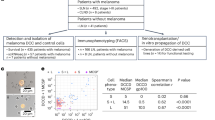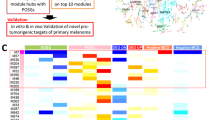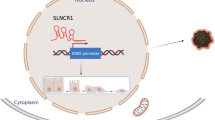Abstract
Stem cell factor (SCF), the ligand for c-Kit, is known to regulate developmental and functional processes of haematopoietic stem cells, mast cells and melanocytes. Two different splice variants form predominantly soluble (sSCF or SCF-1) and in addition some membrane-bound SCF (mSCF or SCF-2). In order to explore the prognostic significance of these molecules in melanoma, total SCF, SCF splice variants and c-Kit expression were studied in normal skin melanocytes and in 11 different melanoma cell lines, using reverse transcription polymerase chain reaction, immunocytochemistry and enzyme-linked immunosorbent assay. Nine of the 11 melanoma cell lines expressed SCF-1 mRNA, only two of them SCF-2, and these two also SCF-1. Coexpression of both SCF-1 and c-Kit was noted in five cell lines, and only one cell line as well as normal melanocytes expressed both SCF-1 and SCF-2 as well as c-Kit. Corresponding results were obtained on immunocytochemical staining. Of three exemplary melanoma cell lines studied, two expressing SCF mRNA also released SCF spontaneously and on stimulation, whereas the line lacking SCF and c-kit mRNA (SK-Mel-23) failed to do so. These data demonstrate thus that melanoma cell lines, particularly those known to metastasize in vivo, lose the ability to express SCF-2 mRNA, suggesting that this molecule may serve, next to c-Kit, as a prognostic marker for malignant melanoma. © 2000 Cancer Research Campaign
Similar content being viewed by others
Article PDF
Change history
16 November 2011
This paper was modified 12 months after initial publication to switch to Creative Commons licence terms, as noted at publication
References
Artuc M, Nürnberg W, Czarnetzki BM and Schadendorf D (1995) Characterization of gene regulatory elements for selective gene expression in human melanoma cells. Biochem Biophys Res Commun 213: 699–705
Bosenberg MW and Massague J (1993) Juxtacrine cell signaling molecules. Curr Opin Cell Biol 5: 832–838
Cohen PS, Chan JP, Lipkunskaya M, Biedler JL and Seeger RC (1994) Expression of stem cell factor and c-kit in human neuroblastoma. The Children’s Cancer Group. Blood 84: 3465–3472
Costa JJ, Demetri GD, Harrist TJ, Dvorak AM, Hayes DF, Merica EA, Menchaca DM, Gringeri AJ, Schwartz LB and Galli SJ (1996) Recombinant human stem cell factor (kit ligand) promotes human mast cell and melanocyte hyperplasia and functional activation in vivo. J Exp Med 183: 2681–2686
Dippel E, Haas N, Grabbe J, Schadendorf D, Hamann K and Czarnetzki BM (1995) Expression of the c-kit receptor in hypomelanosis: a comparative study between piebaldism, naevus depigmentosus and vitiligo. Br J Dermatol 132: 182–189
Flanagan JG, Chan DC and Leder P (1991) Transmembrane form of the kit ligand growth factor is determined by alternative splicing and is missing in the Sld mutant. Cell 64: 1025–1035
Grabbe J, Welker P, Dippel E and Czarnetzki BM (1994) Stem cell factor, a novel cutaneous growth factor for mast cells and melanocytes. Arch Dermatol Res 287: 78–84
Grabbe J, Welker P, Rosenbach T, Nürnberg W, Krüger-Krasagakes S, Artuc M, Fiebiger E and Henz BM (1996) Release of stem cell factor (SCF) from human keratinocytes (HaCaT) is increased in differentiating versus proliferating cells. J Invest Dermatol 107: 219–224
Grichnik JM, Crawford J, Jimenez F, Kurtzberg J, Buchanan M, Blackwell S, Clark RE and Hitchcock MG (1995) Human recombinant stem-cell factor induces melanocytic hyperplasia in susceptible patients. J Am Acad Dermatol 33: 577–583
Guo CS, Wehrle-Haller B, Rossi J and Ciment G (1997) Autocrine regulation of neural crest cell development by Steel factor. Dev Biol 184: 61–69
Hamann K, Grabbe J, Welker P, Haas N, Algermissen B and Czarnetzki BM (1994) Phenotypic evaluation of cultured human mast and basophilic cells and of normal human skin mast cells. Arch Dermatol Res 286: 380–385
Hamann K, Haas N, Grabbe J and Czarnetzki BM (1995) Expression of stem cell factor in cutaneous mastocytosis. Br J Dermatol 133: 203–208
Hartmann K, Henz BM, Krüger-Krasagakes S, Köhl J, Burger R, Guhl S, Haase I, Lippert U and Zuberbier T (1997) C3a and C5a stimulate chemotaxis of human mast cells. Blood 89: 2863–2870
Herlyn M (1990) Human melanoma: development and progression. Cancer Metastasis Rev 9: 101–112
Herlyn M, Thurin J, Balaban G, Bennicelli JL, Herlyn D, Elder DE, Bondi E, Guerry D, Nowel P and Clark WH (1985) Characteristics of cultured human melanocytes isolated from different stages of tumor progression. Cancer Res 45: 5670–5476
Huang EJ, Nocka KH, Buck J and Besmer P (1992) Differential expression and processing of two cell associated forms of the kit-ligand: KL-1 and KL-2. Mol Biol Cell 3: 349–362
Huang S, Luca M, Gutman M, McConkey DJ, Langley KE, Lyman SD and Bar Eli M (1996) Enforced c-KIT expression renders highly metastatic human melanoma cells susceptible to stem cell factor-induced apoptosis and inhibits their tumorigenic and metastatic potential. Oncogene 13: 2339–2347
Inoue M, Kyo S, Fujita M, Enomoto T and Kondoh G (1994) Coexpression of the c-kit receptor and the stem cell factor in gynecological tumors. Cancer Res 54: 3034–3053
Lahav R, Lecoin L, Ziller C, Nataf V, Carnahan JF, Martin FH and Le Douarin NM (1994) Effect of the Steel gene product on melanogenesis in avian neural crest cell cultures. Differentiation 58: 133–139
Longley BJ Jr, Morganroth GS, Tyrrell L, Ding TG, Anderson DM, Williams DE and Halaban R (1993) Altered metabolism of mast-cell growth factor (c-kit ligand) in cutaneous mastocytosis. N Engl J Med 328: 1302–1307
Longley BJ, Tyrrell L, Ma Y, Williams DA, Halaban R, Langley K, Lu HS and Schechter NM (1997) Chymase cleavage of stem cell factor yields a bioactive, soluble product. Proc Nat Acad Sci USA 94: 9017–9021
Lu C and Kerbel RS (1993) Interleukin-6 undergoes transition from paracrine growth inhibitor to autocrine stimulator during human melanoma progression. J Cell Biol 120: 1281–1288
Luo D, Chen H, Searles G and Jimbow K (1995) Coordinated mRNA expression of c-Kit with tyrosinase and TRP-1 in melanin pigmentation of normal and malignant human melanocytes and transient activation of tyrosinase by Kit/SCF-R. Melanoma Res 5: 303–309
Majumdar MK, Feng L, Medlock E, Toksoz D and Williams DA (1994) Identification and mutation of primary and secondary proteolytic cleavage sites in murine stem cell factor cDNA yields biologically active, cell-associated protein. J Biol Chem 269: 1237–1242
Miura N and Suda T (1992) Stem cell factor/c-kit interaction in primordial germ cell, melanoblast and hematopoietic progenitors. Gan To Kagaku Ryoho 19: 1777–1785
Natali PG, Nicotra MR, Winkler AB, Cavaliere R, Bigott A and Ullrich A (1992) Progression of human cutaneous melanoma is associated with loss of expression of c-kit proto-oncogene receptor. Int J Cancer 52: 197–201
Papadimitriou CA, Topp MS, Serve H, Oelmann E, Koenigsmann M, Meurer J, Oberberg D, Reufi B, Thiel E and Berdel WE (1995) Recombinant human stem cell factor does exert minor stimulation of growth in small lung cancer and melanoma cell lines. Eur J Cancer Part A: Gen Top 31: 2371–2378
Ramenghi U, Ruggieri L, Dianzani I, Rosso C, Brizzi MF, Camashcella C, Pietsch T and Saglio G (1994) Human peripheral blood granulocytes and myeloid cell lines express both transcripts encoding for stem cell factor. Stem Cells 12: 521–526
Ratajczak MZ, Luger SM, DeRiel K, Abrahm J, Calabretta B and Gewirtz AM (1992) Role of the KIT protooncogene in normal and malignant human hematopoiesis. Proc Natl Acad Sci USA 89: 1710–1714
Schadendorf D, Gawlik C, Haney U, Ostmeier H, Suter L and Czarnetzki BM (1993 a) Tumor progression and metastatic behavior in vivo correlates with integrin expression on melanocytic tumors. J Pathol 170: 429–434
Schadendorf D, Möller A, Algermissen B, Worm M, Sticherling M and Czarnetzki BM (1993 b) IL-8 produced by human malignant melanoma cells in vitro is an essential autocrine growth factor. J Immunol 151: 2667–2675
Schadendorf D, Kohlmus C, Gawlik C, Suter L and Czarnetzki BM (1995) Mast cells in melanocytic tumours. Arch Dermatol Res 287: 452–456
Schadendorf D, Fichtner I, Makki A, Alijagic S, Kupper M, Mrowietz U and Henz BM (1996) Metastatic potential of human melanoma cells in nude mice – characterisation of phenotype, cytokine secretion and tumour-associated antigens. Br J Cancer 74: 194–199
Scott G, Ewing J, Ryan D and Abboud C (1994) Stem cell factor regulates human melanocyte–matrix interactions. Pigment Cell Res 7: 44–51
Sviderskaya EV, Wakeling WF and Bennett DC (1995) A cloned, immortal line of murine melanoblasts inducible to differentiate to melanocytes. Development 121: 1547–1557
Takahashi H, Saitoh K, Kishi H and Parsons PG (1995) Immunohistochemical localisation of stem cell factor (SCF) with comparison of its receptor c-Kit proto-oncogene product (c-KIT) in melanocytic tumours. Virchows Arch 427: 283–288
Tokunaga K, Nakamura Y, Sakata K, Fujimori K, Ohkubo M, Sawada K and Sakiyama S (1987) Enhanced expression of a glyceraldehyde-3-phosphate dehydrogenase gene in human lung cancers. Cancer Res 47: 5616–5619
Turner AM, Zsebo KM, Martin F, Jacobsen FW, Bennett LG and Broudy VC (1992) Nonhematopoietic tumor cell lines express stem cell factor and display c-kit receptors. Blood 80: 374–381
Van Muijen GN, Jansen KF, Cornelissen IM, Smeets DF, Beck JL and Ruiter DJ (1991) Establishment and characterization of a human melanoma cell line (MV3) which is highly metastatic in nude mice. Int J Cancer 48: 85–91
Wehrle Haller B and Weston JA (1995) Soluble and cell-bound forms of steel factor activity play distinct roles in melanocyte precursor dispersal and survival on the lateral neural crest migration pathway. Development 121: 731–742
Welker P, Grabbe J and Henz BM (1999) Human mast cells produce and differentially express soluble and membrane-bound stem cell factor. Scand J Immunol 49: 495–500
Worm M, Reichert U, Czarnetzki BM and Schadendorf D (1993) Expression of growth factor receptors on human melanoma cells: comparison of modulating effects of interferons and retinoids. Exp Dermatol 2: 217–223
Zsebo KM, Williams DA, Geissler EN, Broudy VC, Martin FH, Atkins HL, Hsu RY, Birkett NC, Okino KH, Murdock DC, Jacobson FW, Langley KE, Smith KA, Takeishi T, Cattenac BM, Galli SJ and Suggs SV (1990) Stem cell factor is encoded at the Sl locus of the mouse and is the ligand for the c-kit tyrosine kinase receptor. Cell 63: 213–224
Author information
Authors and Affiliations
Rights and permissions
From twelve months after its original publication, this work is licensed under the Creative Commons Attribution-NonCommercial-Share Alike 3.0 Unported License. To view a copy of this license, visit http://creativecommons.org/licenses/by-nc-sa/3.0/
About this article
Cite this article
Welker, P., Schadendorf, D., Artuc, M. et al. Expression of SCF splice variants in human melanocytes and melanoma cell lines: potential prognostic implications. Br J Cancer 82, 1453–1458 (2000). https://doi.org/10.1054/bjoc.1999.1076
Received:
Revised:
Accepted:
Published:
Issue date:
DOI: https://doi.org/10.1054/bjoc.1999.1076
Keywords
This article is cited by
-
In vitro evaluation of the effects of human umbilical cord extracts on human fibroblasts, keratinocytes, and melanocytes
In Vitro Cellular & Developmental Biology - Animal (2014)
-
The stem cell factor antibody enhances the chemotherapeutic effect of adriamycin on chemoresistant breast cancer cells
Cancer Cell International (2012)
-
Lack of clinical efficacy of imatinib in metastatic melanoma
British Journal of Cancer (2005)
-
Complex regulation of acetylcholinesterase gene expression in human brain tumors
Oncogene (2002)



